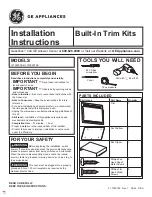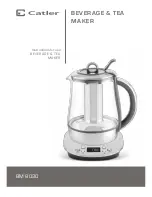
INSTALLATION
Installing
the
cooker
The kitchen should be dry and airy
and have effective ventilation
according to the existing technical
provisions.
The room should be equipped with a
ventilation system that pipes away
exhaust fumes created during
combustion. This system should
consist of a ventilation grid or hood.
Hoods should be installed according
to the manufacturer’s instructions.
The cooker should be placed so as to
ensure free access to all control
elements.
Coating or veneer used on fitted
furniture must be applied with a heat
resistant adhesive (100
℃
). This
prevents surface deformation or
detachment of the coating. If you are
unsure of your furniture’s heat
resistance, you should leave
approximately 2 cm of free apace
around the cooker. The wall behind
the cooker should be resistant to high
temperatures. During operation, its
back side can warm up to around
50
℃
above the ambient temperature.
The cooker should stand on a hard,
even floor (do not put it on a base.)
Before you start using the cooker it
should be leveled, which is particularly
important for fat distribution in a frying
purpose, adjustable feet
are accessible after removal of the
drawer. The adjustment range is +/- 5
mm.
●
Install the cover
Take the cover and cooker out of the
packaging.
Select a proper place, and steadily
level the cooker.
Insert the plastic cover overturn into
the seat of the oven overturn, which is
installed in cooktop.
Electrical
connection
Caution
!
All electrical work should be carried out by a suitably qualified and authorized electrician.
No alterations or willful changes in the electricity supply should be carried out.
Fitting
guidelines
The cooker is manufactured to work with three-phase alternating current (400V 3N~50Hz).
The voltage rating of the cooker heating elements is 230V. Adapting the cooker to operate
with one-phase current is possible by appropriate bridging in the connection box according
to the connection diagram below. The connection diagram is also found on the cover of the
connection box. Remember that the connection wire should match the connection type and
the power rating of the cooker.
CONNECTION DIAGRAM
Caution! Voltage of heating elements 230V
Caution! In the event of any connection the safety
Wire must be connected to the
E terminal.
Recommended
type of
connection
lead
1
For 230V earthed one-phase
connection, bridges connect 1-2-3
terminals and 4-5 terminals, safety
wire to
.
L1
N
E
H05VV-F3G4
2
For 400/230V earthed two-phase
connection, bridges connect 2-3
terminals and 4-5 terminals, the safety
wire to
L1
E
N
N
L2
H05VV-F4G2,5
3
For 400/230V earthed three-phase
connection, bridges connect 4-5
terminals, phases in succession 1,2
and 3, earth to 4-5, the safety wire to
.
N
E
L1
L2
L3
H05VV-F5G1,5
L1=R, L2=s, L3=T, N=earth terminal, E=safety wire terminal
1
2
3
4
The connection cable must be secured in a strain-relief clamp.
Caution
!
Remember to connect the safety circuit to the connection box terminal marked with
. The
electricity supply for the cooker must have a safety switch which enables the power to be
cut off in case of emergency. The distance bet
ween the working contacts of the safety
switch must be at least 3 mm.
Before connecting the cooker to the power supply it is important to read the information on
the data plate and the connection diagram.
INSTALLATION
8
9
pan. To this
750mm
750mm
2cm
2cm
2cm
2cm
2cm
2cm






























